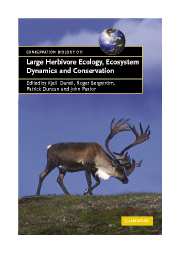Book contents
- Frontmatter
- Contents
- List of contributors
- Preface
- Introduction
- 1 Large herbivores across biomes
- 2 Living in a seasonal environment
- 3 Linking functional responses and foraging behaviour to population dynamics
- 4 Impacts of large herbivores on plant community structure and dynamics
- 5 Long‐term effects of herbivory on plant diversity and functional types in arid ecosystems
- 6 The influence of large herbivores on tree recruitment and forest dynamics
- 7 Large herbivores: missing partners of western European light‐demanding tree and shrub species?
- 8 Frugivory in large mammalian herbivores
- 9 Large herbivores as sources of disturbance in ecosystems
- 10 The roles of large herbivores in ecosystem nutrient cycles
- 11 Large herbivores in heterogeneous grassland ecosystems
- 12 Modelling of large herbivore–vegetation interactions in a landscape context
- 13 Effects of large herbivores on other fauna
- 14 The future role of large carnivores in terrestrial trophic interactions: the northern temperate view
- 15 Restoring the functions of grazed ecosystems
- 16 Themes and future directions in herbivore‐ecosystem interactions and conservation
- Index
- References
14 - The future role of large carnivores in terrestrial trophic interactions: the northern temperate view
Published online by Cambridge University Press: 16 November 2009
- Frontmatter
- Contents
- List of contributors
- Preface
- Introduction
- 1 Large herbivores across biomes
- 2 Living in a seasonal environment
- 3 Linking functional responses and foraging behaviour to population dynamics
- 4 Impacts of large herbivores on plant community structure and dynamics
- 5 Long‐term effects of herbivory on plant diversity and functional types in arid ecosystems
- 6 The influence of large herbivores on tree recruitment and forest dynamics
- 7 Large herbivores: missing partners of western European light‐demanding tree and shrub species?
- 8 Frugivory in large mammalian herbivores
- 9 Large herbivores as sources of disturbance in ecosystems
- 10 The roles of large herbivores in ecosystem nutrient cycles
- 11 Large herbivores in heterogeneous grassland ecosystems
- 12 Modelling of large herbivore–vegetation interactions in a landscape context
- 13 Effects of large herbivores on other fauna
- 14 The future role of large carnivores in terrestrial trophic interactions: the northern temperate view
- 15 Restoring the functions of grazed ecosystems
- 16 Themes and future directions in herbivore‐ecosystem interactions and conservation
- Index
- References
Summary
… I have lived to see state after state extirpate its wolves. I have watched the face of many new wolfless mountains, and seen the south‐facing slopes wrinkle with a maze of new deer trails. I have seen every edible bush and seedling browsed, first to anemic desuetude, and then to death … I now suspect that just as a deer herd lives in mortal fear of its wolves, so does a mountain live in mortal fear of its deer.
Aldo Leopold 1949.INTRODUCTION
Central to any treatment of factors affecting the ecological role of large herbivores is a discussion about the factors influencing large herbivore population size and dynamics, and whether they are most influenced by top‐down, or bottom‐up, processes (Pace et al. 1999). The role of resource limitation (a bottom‐up process) in herbivore dynamics is well‐documented from many studies throughout the temperate zone (e.g. Fowler 1987, Gaillard et al. 2000). In contrast, the extent to which predation (a top‐down process) influences herbivore dynamics is less clear, at least in part due to the fact that many of the most detailed long‐term studies of herbivore population dynamics have been conducted in predator‐free environments. The conceptual elegance of strong top‐down effects on herbivores is clear in prosaic statements like Leopold's in the opening quotation, although the absence, or redundancy, of this effect has lain behind the philosophical adoption of the ‘natural regulation’ doctrine in US national parks.
- Type
- Chapter
- Information
- Large Herbivore Ecology, Ecosystem Dynamics and Conservation , pp. 413 - 448Publisher: Cambridge University PressPrint publication year: 2006
References
- 15
- Cited by

